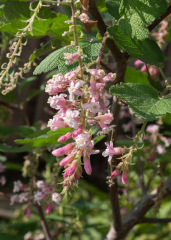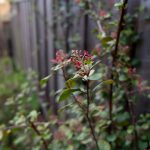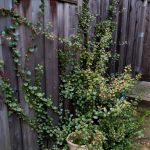Showcase Feature
Lorraine’s garden is an example of how a small space can prioritize native plants and animals and also provide significant sustenance for humans. A focus on local keystone native plants, which provide excellent habitat for insects and the animals that feast on them, maximizes the value of the yard for local wildlife. Lorraine also has a number of fruit trees; the blooming natives attract pollinators that benefit the fruit trees; the trees in turn share their bounty (and nesting branches) with birds.Other Garden Attractions
• A number of plants were selected for their fragrance; check out the coyote mint, pitcher and Sonoma sages, and the more subtle scents of the lilac verbena and evergreen currant.• The offspring of clarkia seeds scattered years ago in one part of the garden now freely color the entire property with their blooms in spring.
Gardening for Wildlife
The sound of water splashing into the solar-powered fountains attracts winged as well as two-legged visitors. Plants of varying heights, along with nesting boxes, provide habitat for a wide variety of birds, and a focus on keystone plants provides abundant food for the bird parents that have made nests in the garden, and the lucky chicks that have hatched and fledged in the garden, including oak titmice, Anna’s hummingbirds, titmice, and chickadees.Slowly decomposing tree stumps and leaf litter, which is left on the ground, provide places for slender and arboreal salamanders and newts to live – they have practically eliminated the formerly pesky snail population. There is no dead-heading in this wildlife-friendly garden.
Keystone species (watch this talk by Doug Tallamy!)
Keystone species—our own, local ecological powerhouse plants— in this garden include hollyleaf cherry, oak, currant, thimbleberry, California lilac, lupine, manzanita, wild rose, woodland strawberry, buckwheat, sage, and cream bush.
Green Home Features
When they bought the house eighteen years ago, Lorraine and Victor invested in high quality insulation in the walls and ceiling. Three years ago they added solar panels, attic insulation, reflective aluminum attic liner, and an attic fan that acts as a whole house fan, drawing cool air up from the basement in the summer. Victor, a plumber, designed and installed an electric underfloor radiant heat system which uses a heat pump and large hot water storage tank. The new basement apartment, where their son and daughter-in-law live, is fully electric, with radiators connected to the radiant heat system and a convection oven.
French drains and a drywell, added by the previous owner, reduce rain runoff from this hilltop home, and all downspouts empty into them. Fruit trees planted in the well benefit from the added groundwater and rarely need summer water.
11:00-2:00, Coffee for a Cause
Enjoy a cup of coffee and snacks in the garden, courtesy of Lorraine’s daughter-in-law Liz and friends. And while you’re at it, consider donating to one of two local charities focused on supporting native and immigrant communities and native plant restoration: Peralta Hacienda in Oakland https://www.peraltahacienda.org/ and the City of Oakland’s Youth Employment Partnership https://www.yep.org/what-we-do/youth-programs/. More information on these worthy programs will be available at the coffee cart.
Garden Talk
12:00 “Getting started: The beginner’s step-by-step guide to creating your own wildlife paradise” by Lorraine Mann
Wondering what to make for dinner? Try this great recipe!
East Bay Garden Pesto with Vegetables
At least partially wheelchair accessible? Yes
Photos
Click to see as a slideshow:













